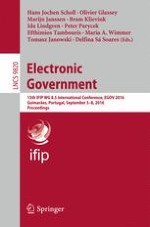2016 | Buch
Electronic Government
15th IFIP WG 8.5 International Conference, EGOV 2016, Guimarães, Portugal, September 5-8, 2016, Proceedings
herausgegeben von: Hans Jochen Scholl, Olivier Glassey, Marijn Janssen, Bram Klievink, Ida Lindgren, Peter Parycek, Efthimios Tambouris, Maria A. Wimmer, Tomasz Janowski, Delfina Sá Soares
Verlag: Springer International Publishing
Buchreihe : Lecture Notes in Computer Science
